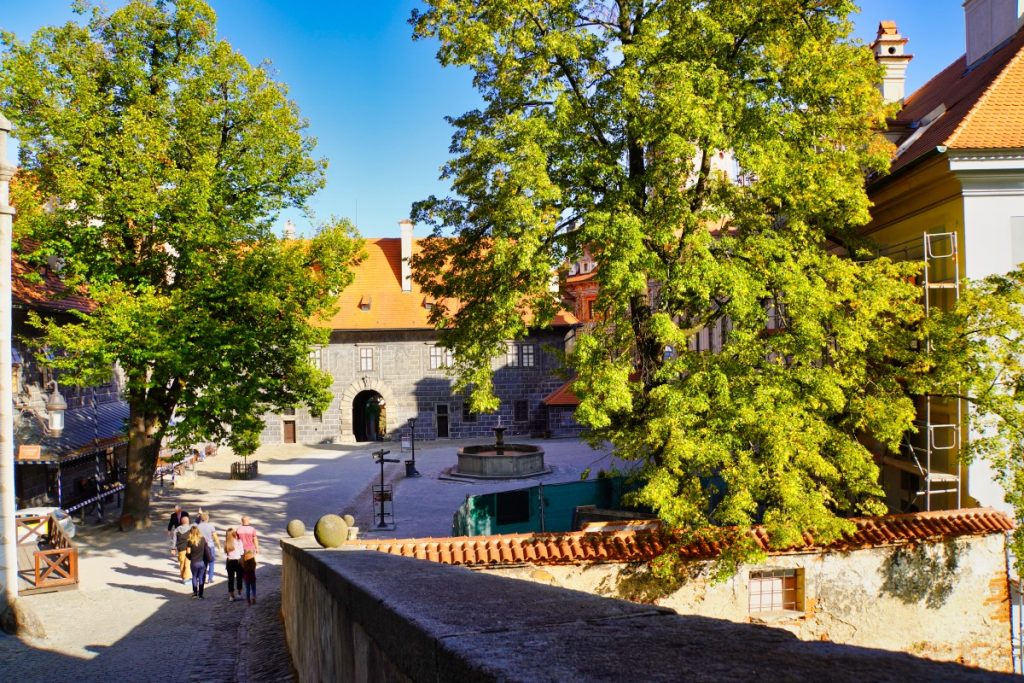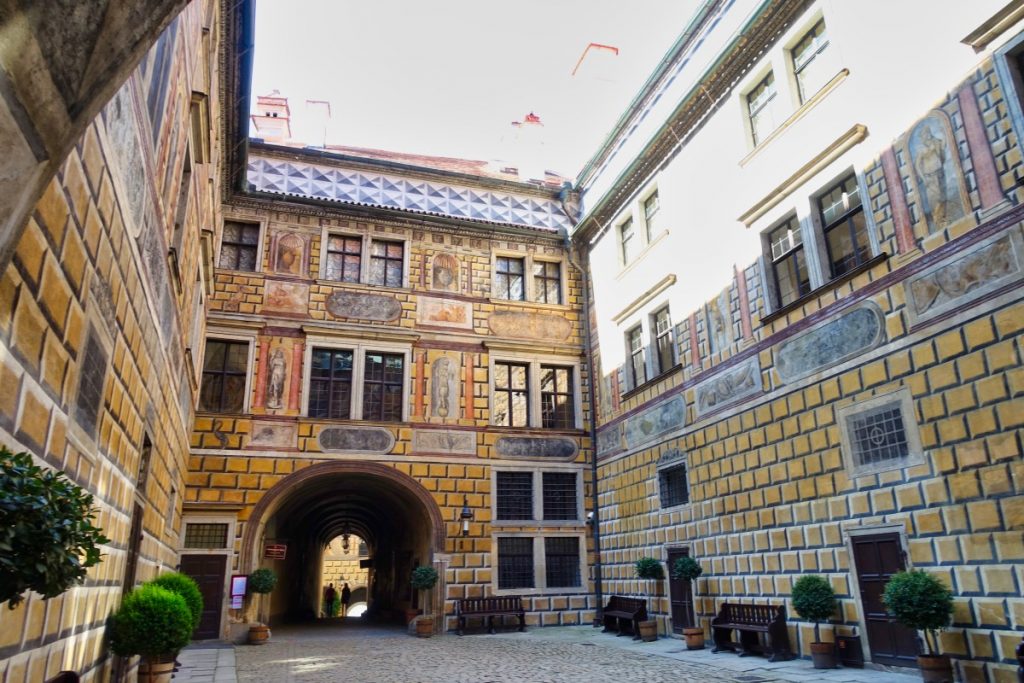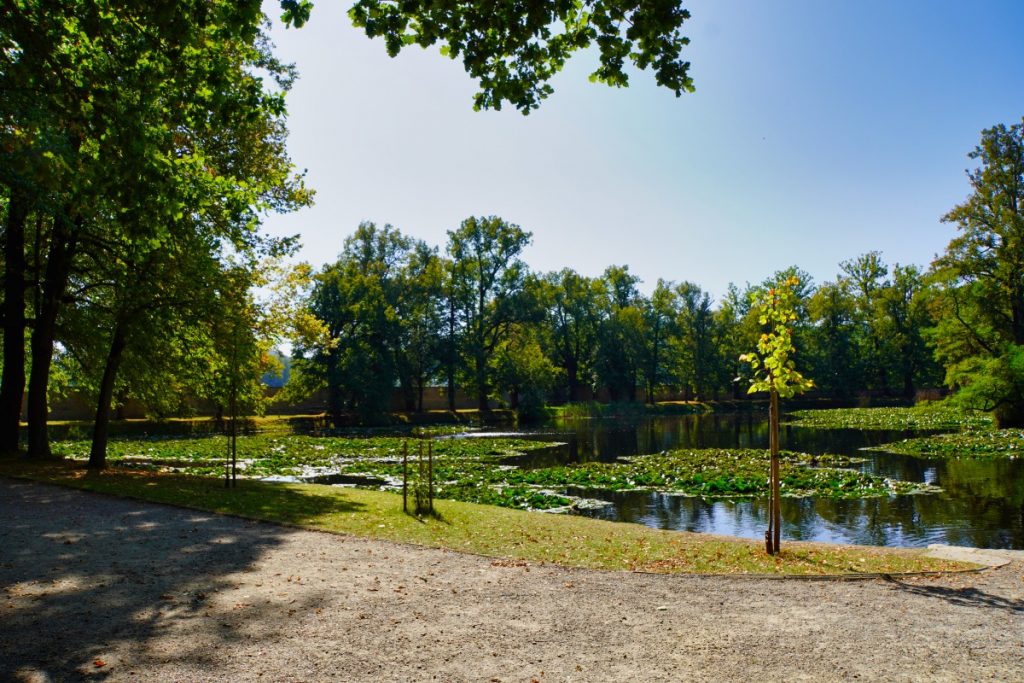Anyone coming to Český Krumlov is sure to visit the castle. The national cultural monument is on the UNESCO World Heritage List and, along with the Old Town, is the highlight of the city.
The castle is situated on a rocky outcrop, which is flowed around by the Vltava River. The name of Krumau Castle describes the landscape on which the castle stands: “krumbe ouwe” means crooked meadow.

History of the castle
Unusual, I think, is the oldest mention there is of today’s castle. The knight and minnesinger Ulrich von Liechtenstein mentioned the castle, which existed at the time, in a poem around 1240. He must have liked it there a lot to deal with it poetically.
From 1302, the von Rosenberg family ruled Krumlov for three centuries. During their reign they built an upper castle, which was later rebuilt into a three-winged palace. Over the years, several state rooms were built, the tower was raised and connected with a Renaissance arcade. Around 1590, a small castle was also built. The last ruler of the von Rosenberg family was Peter Wok von Rosenberg. He had to sell his dominion and with it the castle to Emperor Rudolf II due to an increasing debt burden.

In 1622, the ruler of the time gave the castle and the county to the noble Eggenberg family. Like every new owner, they also began to make changes. They laid out the palace garden and had the Bellaria pleasure palace built.
From 1711 to 1947, the Schwarzenberg family owned the castle and the Krumlov estate. They extended the complex with, for example, the Winter Riding School and a new palace theatre. Particularly impressive is the Mantelbrücke, which was built in 1767 and created a three-storey connection between the residence, garden and theatre.

After the expropriation of the family, the chateau became state property in 1950. Today, the chateau is under the administration of the České Budějovice Monument Institute. They are also responsible for chateau tours, maintenance, construction and restoration work and cultural activities.
Castle stories and legends
The castle of Český Krumlov is surrounded by countless legends and tales. I found some of them very interesting.
The cellar master from Český Krumlov Castle
The old wine of the lord of the castle was stored in the cellars below the castle courtyard IV. It is said that there was a Rosenberg cellar master who had been well occupied with wine for many years and had done excellent work. After his death, he is said to have continued to follow his vocation and to have advised his successors in their work.
Evelyne the Virgin
A theatre company was playing in the castle theatre, in which the virgin Evelyne appeared. She fell madly in love with the actor David, who played the first lover. Unfortunately, he did not return this love. So it came about that in the last act of the play the virgin killed herself with a dagger thrust on stage. Her blood, which dried on the stage boards, could not be washed off for a long time and was a reminder of this misfortune.
The rococo lady
At the first great feast at the Bellarie pleasure palace, a lady suffered from a severe headache. She was advised to drink a full cup of red wine, which would drive away the headache. No sooner said than done, the lady drank the wine, fell on a sofa and never woke up. From then on, at every feast in the pleasure palace, an unknown lady in a red rococo dress and a high pinned-up hairdo appeared among the guests. At the end of the feast, she mysteriously disappeared just as quickly as she had appeared before.
The Water Fairies in the Castle Garden
There is a small lake in the castle garden. Water fairies are said to dance here every night by moonlight. It is said that a treasure is hidden on the small island in the lake, which is guarded by the fairies and dwarves. Supposedly, they give some of the treasure to the one who pleases them well. Many people are said to have tried unsuccessfully to find the treasure.

The White Lady
In the 15th century, Mrs. Perchta von Rosenberg lived in Český Krumlov. Her father married her off against her will to a Moravian nobleman. The latter tortured his wife until his death. On his deathbed he asked Perchta for forgiveness. She did not forgive him and he cursed her. According to legend, she now appears as the ghost of the White Lady in the castles of the von Rosenberg family during important events. The colour of her gloves is said to be a sign of events: white gloves – good event, black gloves – bad event.
Český Krumlov Castle – a discovery tour
The Český Krumlov Castle is the second largest historical building in the Czech Republic after Prague Castle. The castle grounds are really huge. There are 40 buildings and palaces on about 7 hectares, there are 5 castle courtyards, the worth seeing Mantel Bridge, the Bear Kennel and a castle garden.
Some of the buildings can be discovered on guided tours. For example, you can visit Renaissance and Baroque rooms, art objects from the last five centuries, the theatre and the rococo chapel. Unfortunately, we didn’t have enough time for the guided tours and went sightseeing on our own.
Mantelbrücke – a building worth seeing
The landmark of Český Krumlov is the Mantelbrücke, which spans the moat. A really impressive bridge that is one of the viewpoints from the old town. I found the bridge particularly beautiful when it was illuminated in the evening.

The bridge has several storeys and, as it can be seen today, dates from 1777. One passage of the bridge connects the IVth and Vth palace courtyards. The lower passage connects the Maskensaal with the palace theatre (directly into the Royal Lodge), the upper passage connects the palace picture gallery with the palace garden. This corridor even continues over the roof trusses of the palace into the Minorite monastery.

Today you can walk across the open passageway with its beautiful statues and enjoy the view to Český Krumlov.
Bear kennel in the castle moat
Between the I. and II. castle courtyard there is a moat that is part of the Gothic fortifications. It was intended to protect the redoubt and the tower gate and could be crossed via a wooden drop bridge. In the 16th century, the castle complex was rebuilt and, over time, a stone bridge was built that led across a section of the moat. Bears have been kept in this moat since 1707. Correctly read “kept” because bears still live here today.
The bear is the heraldic animal of the von Rosenberg family and Wilhelm von Rosenberg is said to have kept bears as early as the second half of the 16th century. According to reports, the bear pit was home to four bears in 1707. Bears always lived there until the 90s of the 18th century. After a rather short “bear-free” period, Karl zu Schwarzenberg procured a new pair of bears from Transylvania in 1857 and hired a bear breeder. He was responsible for breeding and care for 30 years, but from 1887 onwards there were no more bears living in the bear pit.

In 1907, Prince Sigismund Schönburg-Waldenburg gave the Schwarzenbergers the two female bears Ruschi (†1930) and Ajax (†1935). Today, the 4 bears Vok and Kateřina and their cubs Maria and Hubert live in the moat. The living conditions are, in my opinion, anything but animal-friendly. The animals sit on stony ground, there is little greenery and the sun doesn’t shine very well into the moat either. I can’t understand why they do this to the animals, even if the living conditions are supposed to have improved.
Walk through Český Krumlov Castle
I especially liked the little walk through the castle courtyards. Each courtyard is unique and worth seeing in its own right.
The I. castle yard is the area of the original outer castle. Over the course of time, a farmyard has been created here, which can be entered through the Red Gate. It is located on Latran Street and was given its name because of the red paint.

Around the courtyard are buildings such as the Salzstadel, new pharmacy (was the doctor’s flat), former horse stables (now the Säulensaal), old Burggrafschaft (residence for high officials and castle administrators), a former ice warehouse, a former brewery, … There was even a hospital located on the edge of the courtyard.

Over a stone bridge at the Bärengraben (Bear Pit), you enter the II. castle courtyard through a gate of the mighty bastion. This was the site of the so-called Lower Castle with the Small Castle and the Castle Tower. A staircase in one corner of the courtyard leads to the tower, which can also be climbed. The view is said to be very beautiful. During our visit to Český Krumlov Castle, access was unfortunately not possible.
In 1578, the New Burgraviate was built, which closes off the northern and eastern areas of the courtyard. This building stands on large vaulted cellars (length 48 m, height 4.6 m, width 8.5 m) with an exit to the stables. There was also a small prison here, right next to the rooms for the bears.

To get to the upper castle, you go through a corridor that leads to the III. castle courtyard. The castle complex that grew up around courtyards III and IV was built in several stages (mid-14th – 18th centuries). Both courtyards are much smaller than the previous courtyards and are decorated with beautiful wall paintings. They depict allegorical and mythological scenes and personalities from Greek and Roman history.

Visitors can take part in guided tours of the rooms in the Upper Castle.
From the IV courtyard, you can reach the V. courtyard via the Mantelbrücke. Originally, there were farm buildings here. When the theatre building was erected in 1681, they disappeared. The theatre can be visited on a guided tour.
You leave the castle grounds through an iron gate at the gatehouse.
Castle garden
Directly adjacent to the castle grounds is the castle garden, which invites you to take a stroll. The baroque garden was laid out in the 17th century and is surrounded by a wall. The entire palace park is divided by terraces.

On one of these terraces is the open summer riding school, where horses and riders trained in summer. The rectangular area is lined with lime trees and is no longer recognisable as a riding arena today. Nearby is the winter riding school in an indoor arena.

The second terrace is a large square area with a rococo-style cascading fountain. The area is very well maintained and gardened. Here you can really imagine how the castle residents strolled along the paths.

In the upper garden, which forms another terrace, remnants of the baroque garden are still preserved. There is a square castle pond and regularly laid out paths. The Bellarie pleasure palace is also located here. In front of it is a theatre, still in use today, with a revolving auditorium. Unfortunately, construction work was going on there, and we would have liked to have had a closer look. In the upper part of the palace garden, the paths are mostly lined with trees that provide restful shade on hot days.

The Český Krumlov Castle in the Evening
Those who have the opportunity should definitely take an evening stroll through the castle. From the old town, the castle and the Mantelbrücke are wonderfully illuminated. The courtyards were almost deserted during our visit and we could listen to a concert through the open windows.
Car park P1 (“Parking in the Jelení Garden”) is located below the northern castle wall. It is the largest car park in Český Krumlov with a total capacity of 230 parking spaces.
Different tours are offered, which take place at different times. Prices vary depending on the tour. Exact times and prices can be found on the castle’s website.
On your own, you can visit the castle museum, the castle tower, the horse stables and the tack room. Again, more information can be found on the castle’s website.
The castle park is open from April to October.
Prices vary depending on the tour.
Adults: 50-380 CZK
Price list of the chateau tours
Admission to the chateau park, Mantel Bridge and chateau courtyards is free of charge.










Leave a Reply